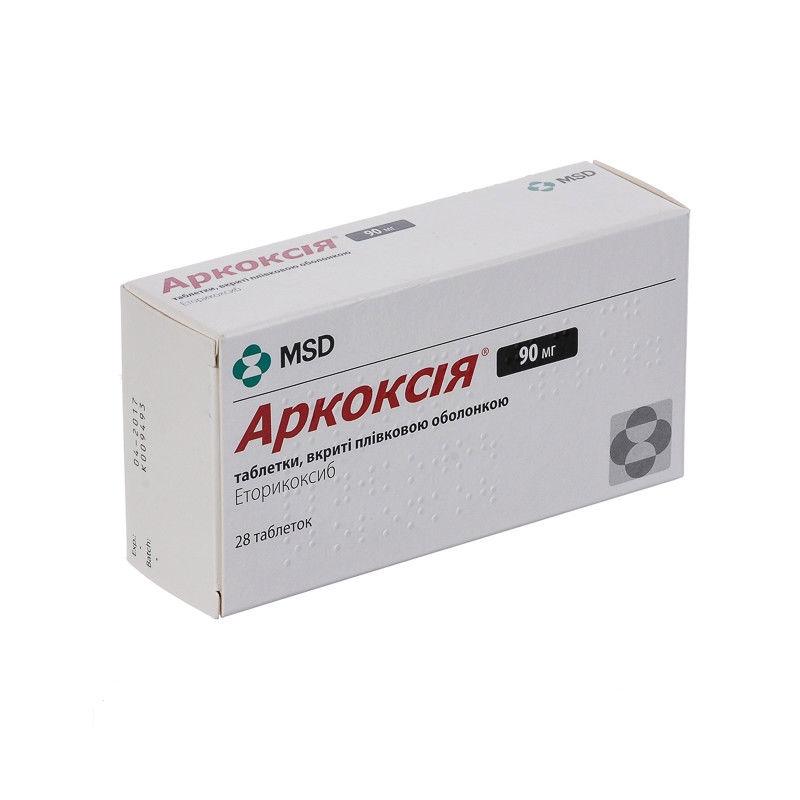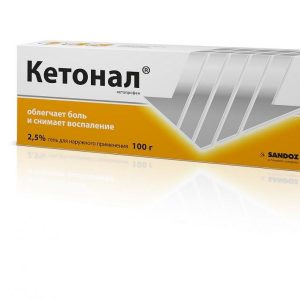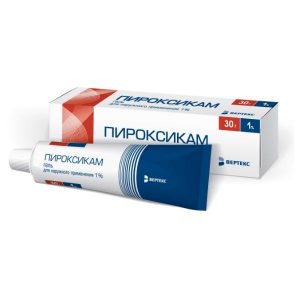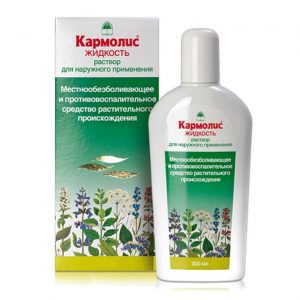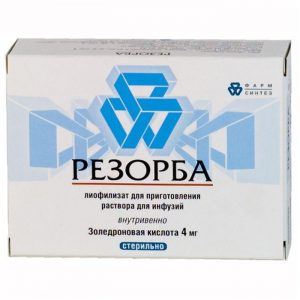Description
Release form
Film-coated tablets.
Packing
28 pcs. 90 mg each.
Pharmacological action of
NSAIDs. A selective COX-2 inhibitor, in therapeutic concentrations, blocks the formation of prostaglandins and has an anti-inflammatory, analgesic and antipyretic effect.
Selective inhibition of COX-2 is accompanied by a decrease in the severity of clinical symptoms associated with the inflammatory process, with no effect on platelet function and gastrointestinal mucosa.
Etoricoxib has a dose-dependent effect of inhibiting COX-2 without affecting COX-1 when used in a daily dose of up to 150 mg. Arcoxia ® does not affect the production of prostaglandins in the gastric mucosa and bleeding time. In the studies conducted, there was no decrease in the level of arachidonic acid and platelet aggregation caused by collagen.
Indications
Symptomatic therapy of the following diseases and conditions:
Osteoarthrosis.
Rheumatoid Arthritis.
Ankylosing spondylitis.
Pain and inflammatory symptoms associated with acute gouty arthritis.
Therapy for moderate to severe acute pain after dental surgery.
Contraindications
Complete or incomplete combination of bronchial asthma, recurrent polyposis of the nose or paranasal sinuses and intolerance to acetylsalicylic acid and other NSAIDs (including a history of).
Erosive-ulcerative changes in the mucous membrane of the stomach or duodenum, active gastrointestinal bleeding, cerebrovascular or other bleeding.
Inflammatory bowel disease (Crohn’s disease, ulcerative colitis) in the acute phase.
Hemophilia and other bleeding disorders.
Severe heart failure (NYHA functional classes II-IV).
Severe liver failure (more than 9 Child-Pugh scores) or active liver disease.
Severe renal failure (CC less than 30 ml / min), progressive kidney disease, confirmed hyperkalemia.
Period after coronary artery bypass grafting, peripheral artery disease, cerebrovascular disease, clinically severe coronary artery disease.
Persistently stored blood pressure values ² ¹ ² ¹exceeding 140/90 mm Hg. Art. with uncontrolled arterial hypertension.
Pregnancy.
Lactation (breastfeeding).
Children under 16 years old.
Hypersensitivity to any component of the drug.
Caution: use the drug if there is anamnestic data on the development of gastrointestinal ulcer, Helicobacter pylori infection, in the elderly, in patients who have been using NSAIDs for a long time, often consuming alcohol, with severe somatic diseases, dyslipidemia / hyperlipidemia, diabetes mellitus, arterial hypertension, edema and fluid retention, smoking, in patients with CC less than 60 ml / min, with concomitant therapy with the following drugs: anticoagulants (e.g. warfarin), antiplatelet agents (on Reamer, acetylsalicylic acid, clopidogrel), corticosteroids (e.g., prednisone), selective serotonin reuptake inhibitors (e.g., citalopram, fluoxetine, paroxetine, sertraline).
Special instructions
Taking the drug Arkoksia ® requires careful monitoring of blood pressure. When administering the drug, all patients should monitor blood pressure during the first two weeks of treatment and periodically thereafter.
Liver and kidney function indicators should also be regularly monitored.
In the case of an increase in the level of hepatic transaminases by 3 times or more relative to VGN, the drug should be discontinued.
Given the increased risk of developing unwanted effects with increasing duration of administration, it is necessary to periodically evaluate the need to continue taking the drug and the possibility of reducing the dose.
The drug should not be used concomitantly with other NSAIDs.
The shell of the drug Arkoksia ® contains a small amount of lactose, which should be taken into account when prescribing the drug to patients with lactase deficiency.
Influence on the ability to drive vehicles and control mechanisms
During the treatment period, care must be taken when driving vehicles and engaging in other potentially dangerous activities, requiring increased concentration of attention and speed of psychomotor reactions. Patients who experience episodes of dizziness, drowsiness, or weakness should refrain from activities requiring concentration.
Composition
1 tablet contains:
Active ingredient:
Etoricoxib 90 mg.
Excipients:
Calcium hydrogen phosphate
Microcrystalline cellulose
Croscarmellose sodium
Magnesium stearate.
Shell composition:
Opadry II white 39K18305
Carnauba wax.
Film composition:
Lactose monohydrate
Hypromellose
Titanium dioxide
Triacetin.
Dosage and administration
The drug is taken orally, regardless of the meal, with a small amount of water.
In osteoarthritis, the recommended dose is 60 mg 1 time / day. The daily dose for osteoarthritis should not exceed 60 mg.
With rheumatoid arthritis and ankylosing spondylitis, the recommended dose is 90 mg 1 time / day. The daily dose for rheumatoid arthritis and ankylosing spondylitis should not exceed 90 mg.
In acute gouty arthritis, the recommended dose in the acute period is 120 mg 1 time / day. The daily dose for acute gouty arthritis should not exceed 120 mg.
The duration of use of the drug in a dose of 120 mg is no more than 8 days. The minimum effective dose should be used as short as possible.
The average therapeutic dose for pain is once 60 mg.
Acute pain after dental surgery: the recommended dose is 90 mg 1 time / day. In the treatment of acute pain, Arkoxia ® should be used only in the acute symptomatic period, limited to no more than 8 days. The daily dose for pain relief after dental surgery should not exceed 90 mg.
In patients with hepatic insufficiency (5-9 points on the Child-Pugh scale), it is recommended not to exceed a daily dose of 60 mg.
Side effects
The frequency of adverse reactions is presented in accordance with the following gradation:
Very often (? 10%).
Often (1-10%).
Infrequently (0.1-1%).
Rarely (0.01-0.1%).
Very rare (<0.01%, including isolated cases). From the digestive system: often – epigastric pain, heartburn, nausea, diarrhea, dyspepsia, flatulence infrequently – bloating, belching, increased peristalsis, constipation, dry oral mucosa, gastritis, gastric or duodenal ulcer, irritable bowel syndrome, esophagitis, oral mucosal ulcers, vomiting very rarely – gastrointestinal ulcers (with bleeding or perforation), hepatitis. From the nervous system: often – headache, dizziness, weakness infrequently – taste disturbance, drowsiness, sleep disturbances, sensory disturbances, incl. paresthesia / hyperesthesia, anxiety, depression, impaired concentration very rarely – hallucinations, confusion. From the senses: infrequently – blurred vision, conjunctivitis, tinnitus, vertigo. From the urinary system: infrequently – proteinuria is very rare – renal failure, usually reversible with discontinuation of the drug. Allergic reactions: very rarely – anaphylactic / anaphylactoid reactions, including a marked decrease in blood pressure and shock. From the cardiovascular system: often – palpitations, increased blood pressure infrequently – hot flashes, cerebrovascular accident, atrial fibrillation, congestive heart failure, nonspecific ECG changes, myocardial infarction is very rare – hypertensive crisis. From the respiratory system: infrequently – cough, shortness of breath, nosebleeds very rarely – bronchospasm. Dermatological reactions: often – ecchymosis is infrequent – facial swelling, itching, rash is very rare – urticaria, Stevens-Johnson syndrome, Lyell’s syndrome. Infectious complications: infrequently – gastroenteritis, infections of the upper respiratory tract, urinary tract. From the musculoskeletal system: infrequently – muscle cramps, arthralgia, myalgia. From the side of metabolism: often – swelling, fluid retention infrequently – changes in appetite, weight gain. From laboratory studies: often – increased activity of hepatic transaminases infrequently – increased nitrogen in blood and urine, increased CPK activity, decreased hematocrit, decreased hemoglobin, hyperkalemia, leukopenia, thrombocytopenia, increased serum creatinine, increased uric acid rarely – increased serum sodium blood. Other: often – flu-like syndrome infrequently – chest pain. Drug Interactions Pharmacodynamic Interactions In patients receiving warfarin, taking Arcoxia ® at a dose of 120 mg / day was accompanied by an increase of about 13% in MHO and prothrombin time. In patients receiving warfarin or similar drugs, MHO should be monitored during initiation of therapy or changes in the dosage regimen of Arkoxia ®, especially in the first few days. There are messages that non-selective NSAIDs and selective COX-2 inhibitors can attenuate the hypotensive effect of ACE inhibitors. This interaction should be taken into account in the treatment of patients taking Arcoxia ® concomitantly with ACE inhibitors. In patients with impaired renal function (for example, with dehydration or in old age), such a combination can aggravate functional renal failure. Arcoxia ® can be used simultaneously with acetylsalicylic acid in low doses intended for the prevention of cardiovascular diseases. However, the simultaneous administration of acetylsalicylic acid in low doses and Arkoxia ® can lead to an increase in the frequency of gastrointestinal ulceration and other complications compared with taking Arkoxia ® alone. After reaching the equilibrium state, taking etoricoxib at a dose of 120 mg 1 time / day does not affect the antiplatelet activity of acetylsalicylic acid in low doses (81 mg / day). The drug does not replace the preventive effect of acetylsalicylic acid in cardiovascular diseases. Cyclosporine and tacrolimus increase the risk of developing nephrotoxicity while taking Arcoxia ®. Pharmacokinetic interaction There is evidence that non-selective NSAIDs and selective COX-2 inhibitors can increase plasma lithium concentration. This interaction should be taken into account in the treatment of patients taking Arcoxia ® simultaneously with lithium. In two studies, the effects of Arkoxia ® at a dose of 60, 90 and 120 mg 1 time / day for seven days were studied in patients receiving methotrexate once a week at a dose of 7, 5 to 20 mg for rheumatoid arthritis. Arcoxia ® at a dose of 60 and 90 mg did not affect the plasma concentration (according to AUC) and renal clearance of methotrexate. In one study, Arcoxia ® at a dose of 120 mg had no effect on plasma concentration (AUC) and renal clearance of methotrexate. In another study, Arcoxia ® at a dose of 120 mg increased the concentration of methotrexate in plasma by 28% (by AUC) and decreased renal clearance of methotrexate by 13%. With the simultaneous administration of Arcoxia ® in doses above 90 mg / day and methotrexate, the possible appearance of toxic effects of methotrexate should be monitored. Oral contraceptives: taking Arcoxia ® in a dose of 120 mg with oral contraceptives containing 35 μg of ethinyl estradiol and from 0.5 to 1 mg of norethindrone for 21 days, simultaneously or with a difference of 12 hours increases the stationary AUC0-24 of ethinyl estradiol by 50-60%. However, the concentration of norethisterone usually does not increase to a clinically significant degree. This increase in the concentration of ethinyl estradiol should be taken into account when choosing the appropriate oral contraceptive for simultaneous use with Arcoxia ®. A similar fact can lead to an increase in the frequency of thromboembolism, due to an increase in the exposure of ethinyl estradiol. No significant pharmacokinetic interaction with GCS was found. Etoricoxib does not affect AUC0-24 in equilibrium or digoxin elimination. At the same time, etoricoxib increases Cmax (by an average of 33%), which may be important in the development of an overdose of digoxin. Concomitant use of Arcoxia ® and rifampicin (a powerful inducer of hepatic metabolism) leads to a 65% decrease in plasma AUC of etoricoxib. This interaction should be considered with the simultaneous administration of Arcoxia ® with rifampicin. Antacids and ketoconazole (a potent inhibitor of CYP3A4) do not have a clinically significant effect on the pharmacokinetics of Arcoxia ®. overdose There have been no reports of overdosage of Arcoxia ® in clinical trials. In clinical trials, a single dose of Arcoxia ® in a single dose of up to 500 mg or repeated administration of up to 150 mg / day for 21 days did not cause significant toxic effects. Symptoms: undesirable effects from the gastrointestinal tract, cardiovascular system and kidneys may occur with an overdose of the drug. Treatment: carry out symptomatic therapy. Etoricoxib is not excreted in hemodialysis, the elimination of the drug in peritoneal dialysis has not been studied. Storage conditions Keep out of the reach and sight of children at temperatures not exceeding 30 ° C. Shelf life 3 years. Deystvuyushtee substance torikoksib dosage form tablets For For For children for doctors, For adults as prescribed by doctor, For children over 16 years old Merck Sharp & Dum BV, Netherlands
